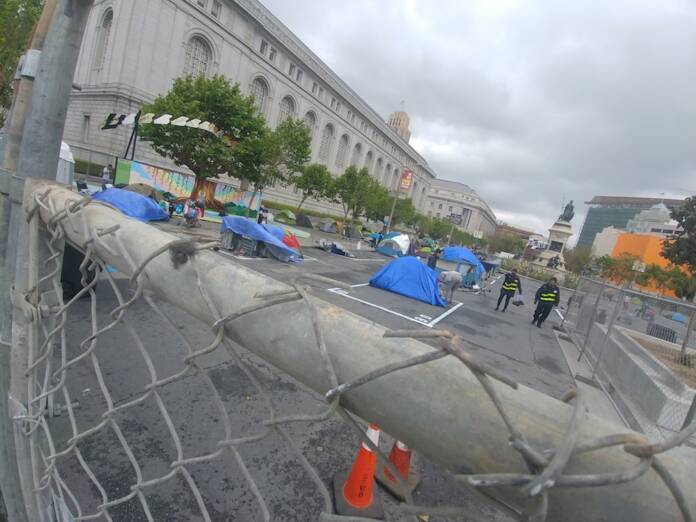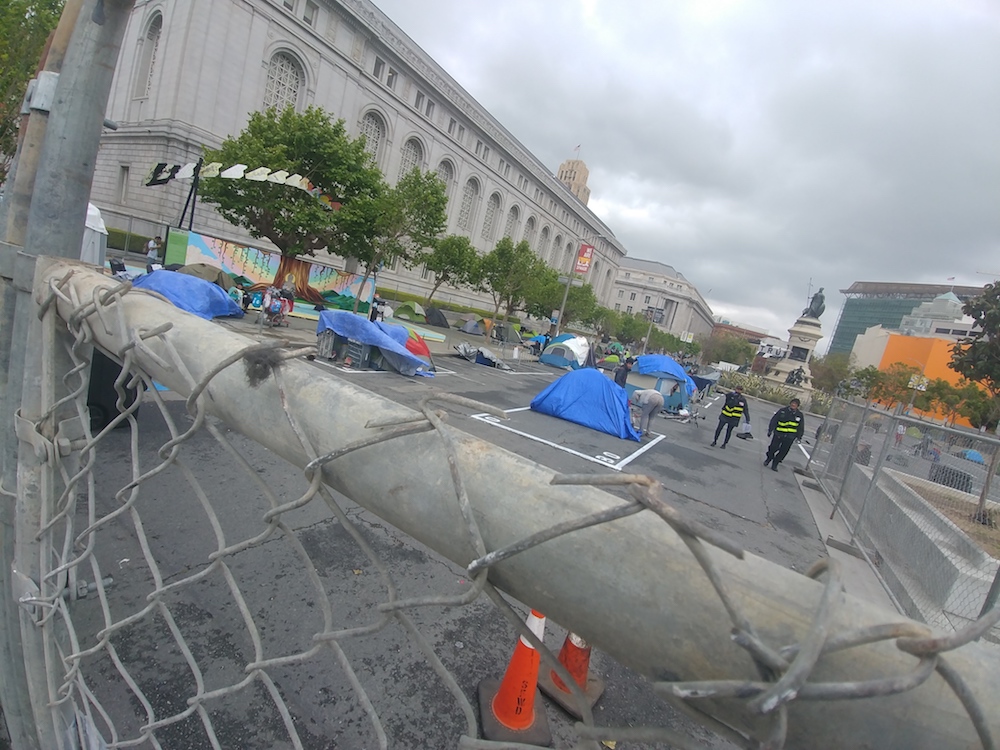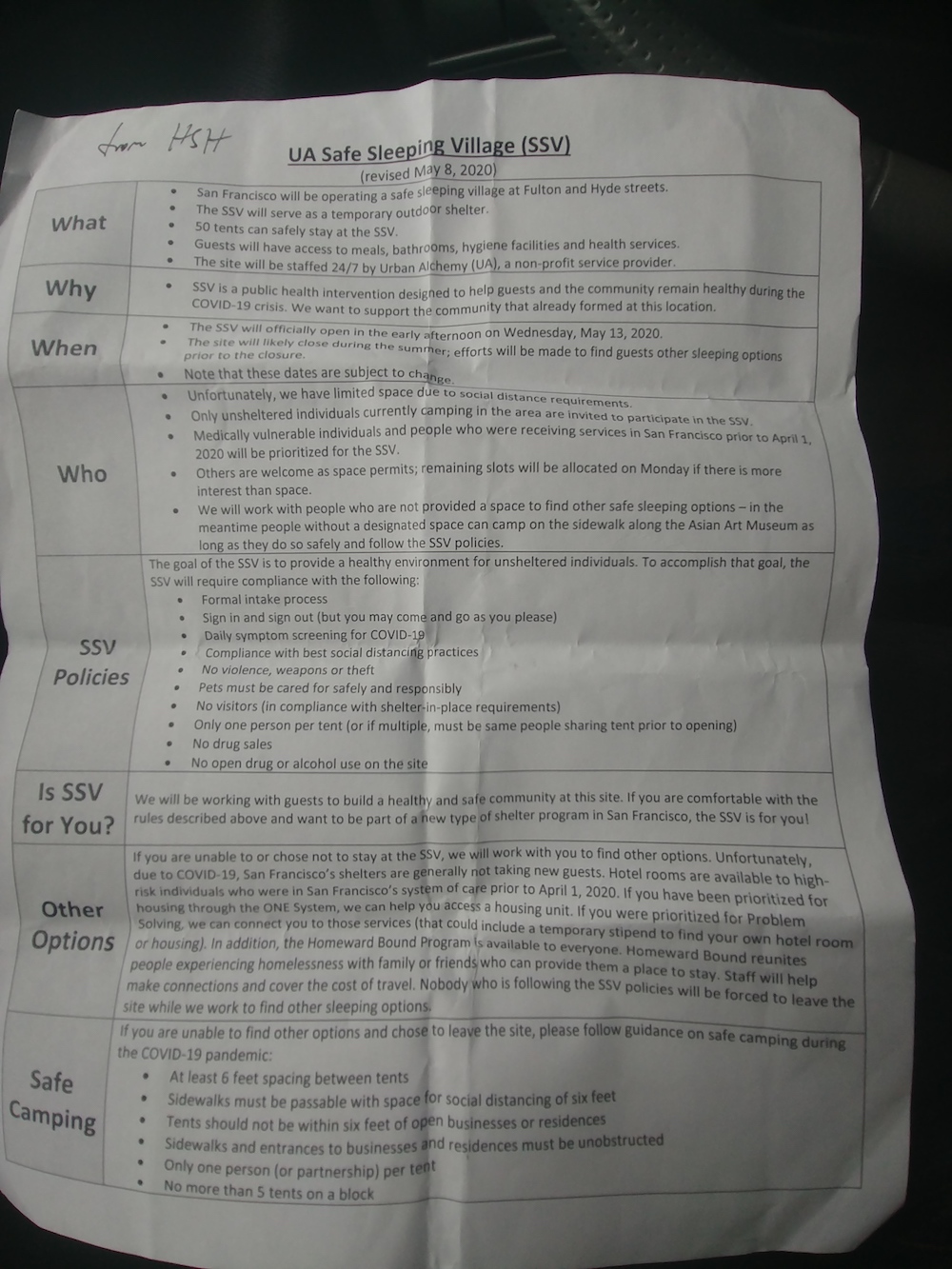
San Francisco’s first city-sanctioned safe sleeping site began operations yesterday afternoon. The site, referred to as the Safe Sleeping Village, has 50 spaces for tents to be pitched six feet apart from each other in a parking lot between the Asian Art Museum and the San Francisco Public Library.
But some residents and activists say that the site is far from adequate, and that people would be better off in hotel rooms.

The Department of Public Works is responsible for cleaning the site, installing hygiene facilities, and installing the entry gates, according to deputy director of operations Larry Stringer. Residents enter from the gate on Hyde St. and the emergency exit gate is on Larkin St.
The city has installed seven portable toilets, including two larger ones accessible to disabled residents of the SSV, on the Western and Eastern sides of the site, two handwashing stations, and a spigot with potable water.
The group tasked with cleaning the toilets and handwashing stations, providing health services, and providing food and drink to the residents of the site is Urban Alchemy, a non-profit services provider. They will also be enforcing social distancing and distributing masks and gloves to residents. According to their CEO and co-founder, Lena Miller, the Urban Alchemy team present was hand-selected based on their prior experience working in encampments in and around Civic Center, and they are all trained in first aid, CPR, and in administering Narcan to drug overdose victims.
“Guests,” as SSV residents are referred to by Urban Alchemy, are allowed to leave and return from the site, but must sign in and out at the gate and cannot stay out longer than 24 hours.
Despite the services available to residents of the SSV, its establishment has some unhoused folks worried. Nick, one of the encampment residents, told me that he feels uncertain about the social distancing requirements being implemented.

“What we have right now (the encampment) is good, I’m with a good group of people. If they break that up, I don’t know what’s gonna happen. We all get along, what if take us away from each other?” said Nick.
Nick told me that what he and others really want are hotel rooms or a stay in SROs in order to socially distance.
“There’s enough room to put us in a hotel or SRO where they can keep us safe away from the virus. Why put us in a parking lot? That SRO could change someone’s life,” said Nick.
Juliana Morris, a member of the Do No Harm Coalition, an activist group comprised of UCSF physicians dedicated to advocating for the public health of marginalized groups in the Bay Area, was also concerned about putting unhoused people into a sanctioned encampment with shared bathrooms and handwashing stations instead of giving them hotel rooms.
“I am concerned. I wish there were more efforts to speed up getting people into hotel rooms. Hotels have some clear health benefits like private bathrooms,” said Morris in a phone interview.
Olivia Park, another member of the Do No Harm Coalition who will soon be a practicing physician, described one scenario where having a shared portable toilet at an encampment could turn into a public health disaster.

“What if one of the porta-potties busts open and if it rains and there’s feces everywhere, that could cause a huge outbreak,” said Park in a phone interview.
Park also told me that she was told by encampment residents that the toilets were not being cleaned after each use, which puts those who use them at risk for contracting COVID-19.
“It blows my mind that these are the alternatives that the city is choosing. It’s better than nothing, but it’s a flimsy band-aid,” said Park.
Another encampment resident, Lisa, told me that the interactions with police have caused unhoused people to lose trust in the city and city workers setting up the SSV. Last night, according to Lisa, police were pointing lights at tents in the Civic Center encampment.
“They started last night with intimidation, pointing headlights at my tent… One was like ‘get out of your tent I know you’re smoking,’ that’s their attitude,” said Lisa.
Lisa said she is also worried that staying in the encampment will interfere with her ability to care of her mother, as she was told by a member of SF HOT, who was present for the set up, that being absent for more than 24 hours is not allowed.
“We’re gonna be prisoners,” said Lisa.
Morris seconded that opinion, telling me that the encampment residents she has spoken with and the presence of “patrolling” city workers and defined borders to the encampment make the residents of the SSV uneasy about living there.
Anxiety felt by homeless folks was further heightened due to police presence at the SSV as it was being set up, according to Lisa. At 8am, there were about ten officers and three cars. By 10am there only three officers at the site but six cars were across the street towards city hall and faced the SSV. Bryan Edwards, an organizer at the Coalition on Homelessness, expressed bewilderment at the presence of SFPD at the SSV during its setup.
“The police have no role in this,” said Edwards.
I contacted SFPD inquiring about the deployment of officers to the SSV, and Public Information Officer Adam Lobsigner replied with the following statement over email:
“Officers from Northern Station, Tenderloin Station, and SFPD’s HSOC Unit are collaborating with fellow city agencies to ensure a safe environment at the Safe Sleeping Village.”
Kelley Cutler, who is also an organizer at the Coalition on Homelessness, told me that she was worried about how living conditions would be at the site. She explained that the areas experience occasional high winds and tents not properly staked down could move or become airborne. The area also gets very hot on sunny days due to the asphalt’s tendency to conduct and reflect heat, and there is no shade to be found in the parking lot.
Miller acknowledged that the SSV, as a safe sleeping site with tents, isn’t perfect, but said it is a positive step that will improve the quality of life for unhoused folks that currently have no other access to shelter.
“The bottom line is that someone’s gotta do something. San Francisco is known for innovation, and we’re trying to be the change.”


